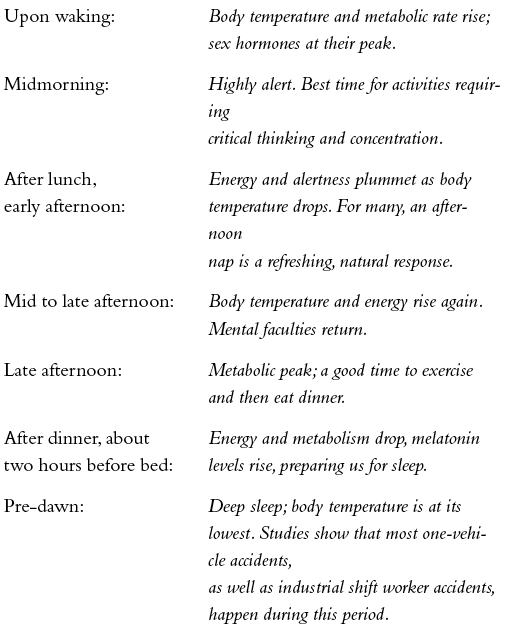How much thought have you given to your body’s energy cycles throughout the day, the month, and the year?
You’re probably familiar with the terms larks and owls, and probably know someone (maybe even yourself) who fits the classic description of a morning or night person. Truth is, though, most of us are not extreme larks or owls, but fall somewhere in the middle. If left to our natural rhythm, we tend to rise somewhere between 7 and 8 a.m., get sleepy around ten at night, and fall asleep by midnight, with variations of up to an hour or two either way.
More important is the fact that, whatever hours we keep, we tend to follow a consistent pattern of energy and bodily function over the course of the day. This inner clock is governed by chemical processes in the human body that synchronize themselves to the light–dark cycle of the environment. Coming to terms with your cycle will help you in everything you do.
If you took your temperature every four hours around the clock, you would probably find that it rose and fell by a few tenths of a degree over a twenty-four-hour period. You’d also find that the periods of higher temperature would correspond with periods of higher energy and mental alertness, while the dips in temperature would correspond with sleep, or with that slump period during the day when you feel the need to rest and recharge.
The standard energy cycle for most of us is:
Most of us have an intuitive sense of our energy profile. Still, it’s uncanny how we try to fight it—to work, eat, or drive when we should be sleeping; or, conversely, to squander our most valuable brain time on activities that could easily be done during less alert periods.
Knowing and, more importantly, respecting your body’s daily energy map is a great way to make yourself more productive, improve the effectiveness of exercise, reduce the likelihood of accidents, improve your sexual performance, and, in general, increase your enjoyment of life.







